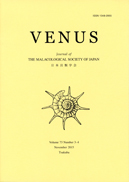Volume 80, Issue 3-4
Displaying 1-4 of 4 articles from this issue
- |<
- <
- 1
- >
- >|
Original Articles
-
Article type: Original Article
2022 Volume 80 Issue 3-4 Pages 47-66
Published: August 26, 2022
Released on J-STAGE: August 26, 2022
Download PDF (3126K) -
Article type: Original Article
2022 Volume 80 Issue 3-4 Pages 67-76
Published: August 26, 2022
Released on J-STAGE: August 26, 2022
Download PDF (1398K) -
Article type: Original Article
2022 Volume 80 Issue 3-4 Pages 77-86
Published: August 26, 2022
Released on J-STAGE: August 26, 2022
Download PDF (894K)
Short Note
-
Article type: Short Note
2022 Volume 80 Issue 3-4 Pages 87-90
Published: August 26, 2022
Released on J-STAGE: August 26, 2022
Download PDF (861K)
- |<
- <
- 1
- >
- >|
